
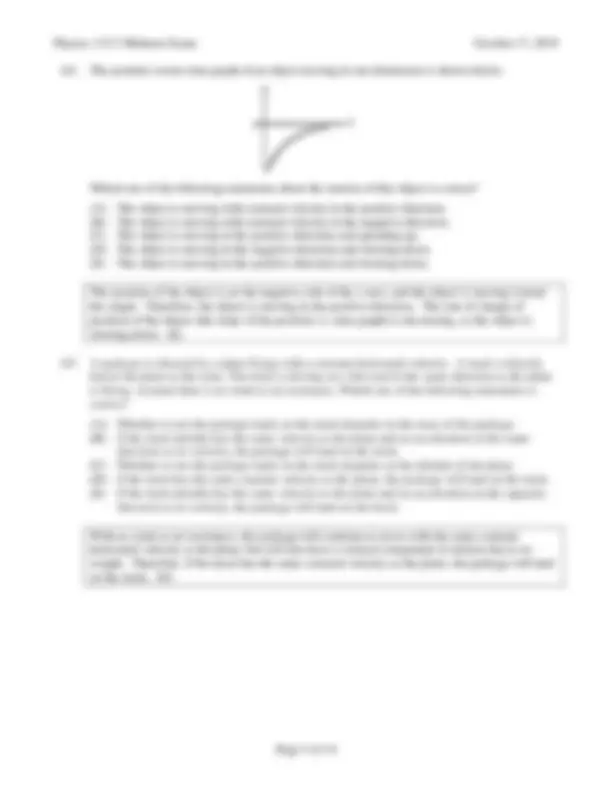
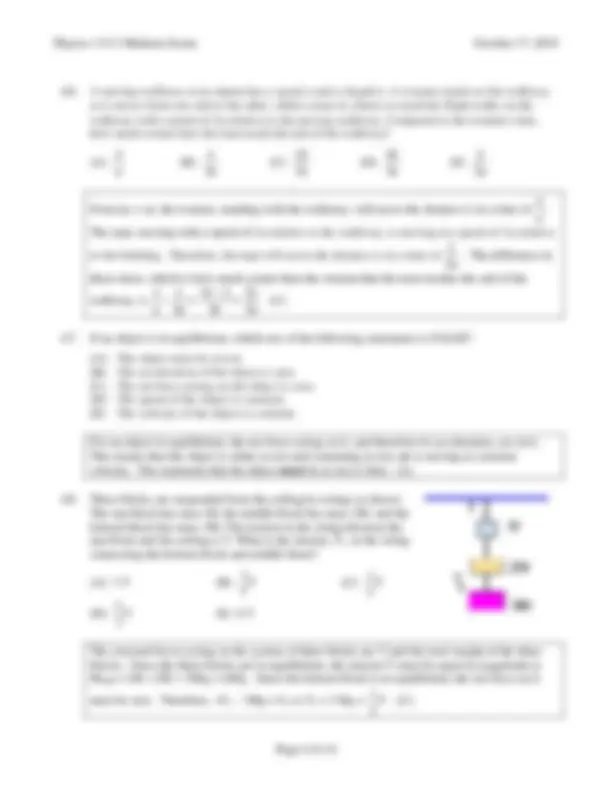
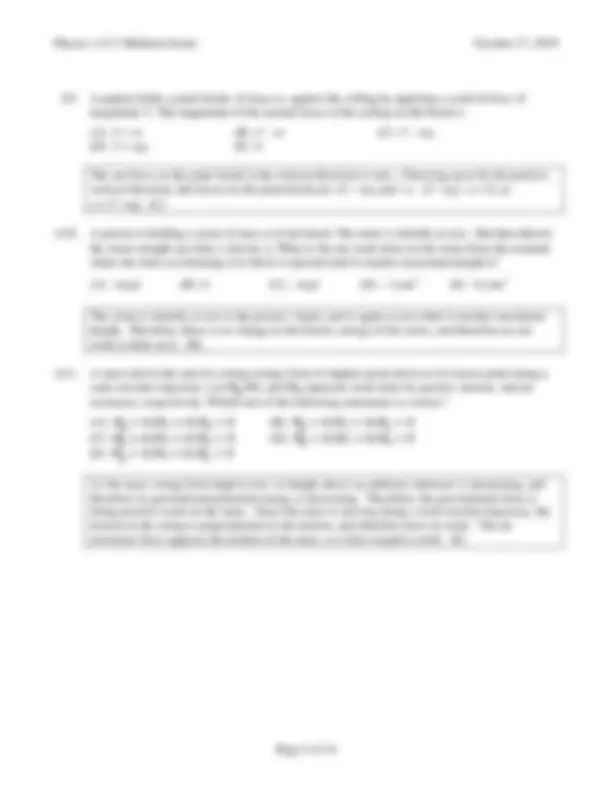
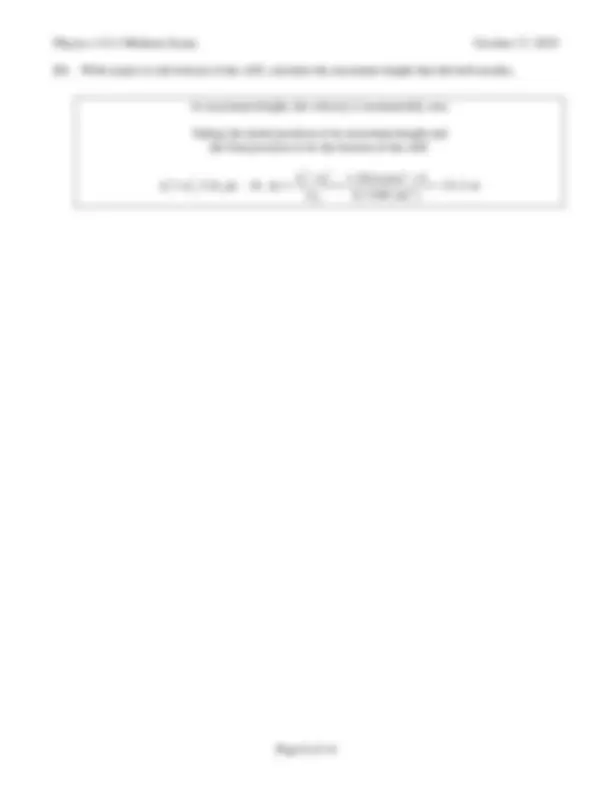
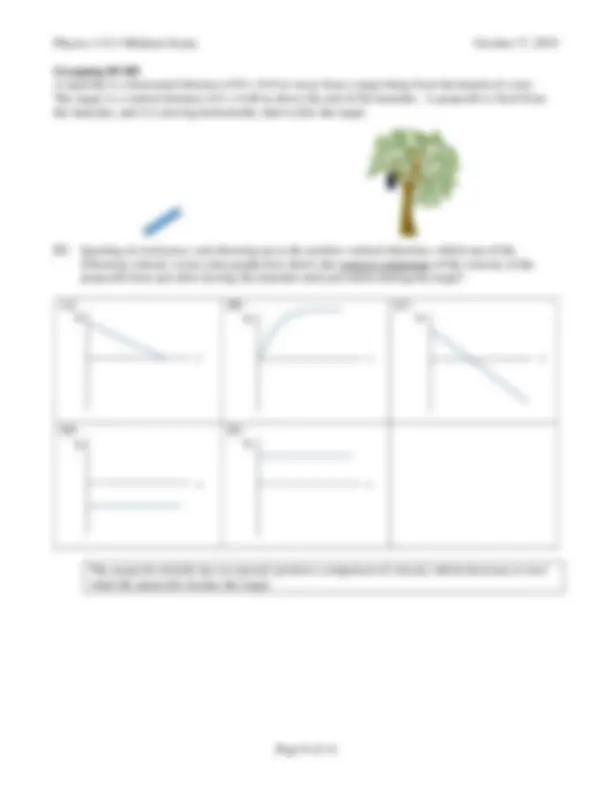
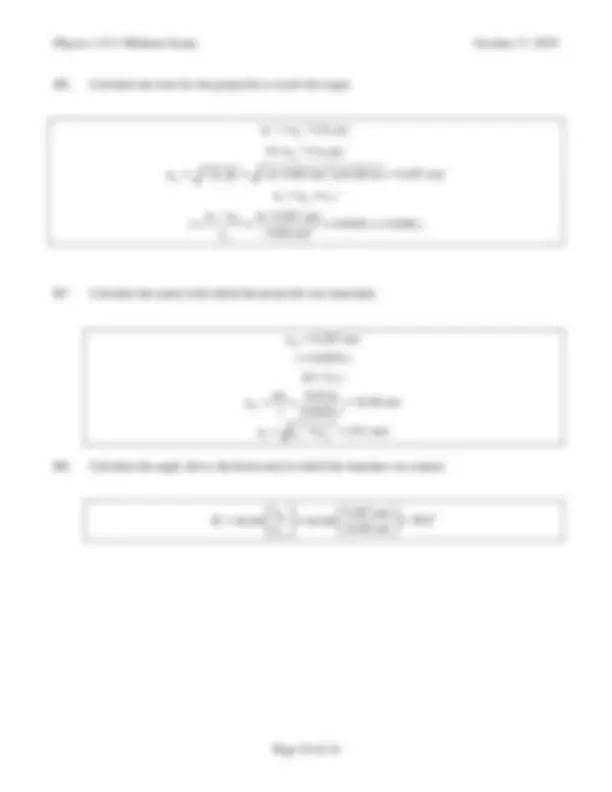
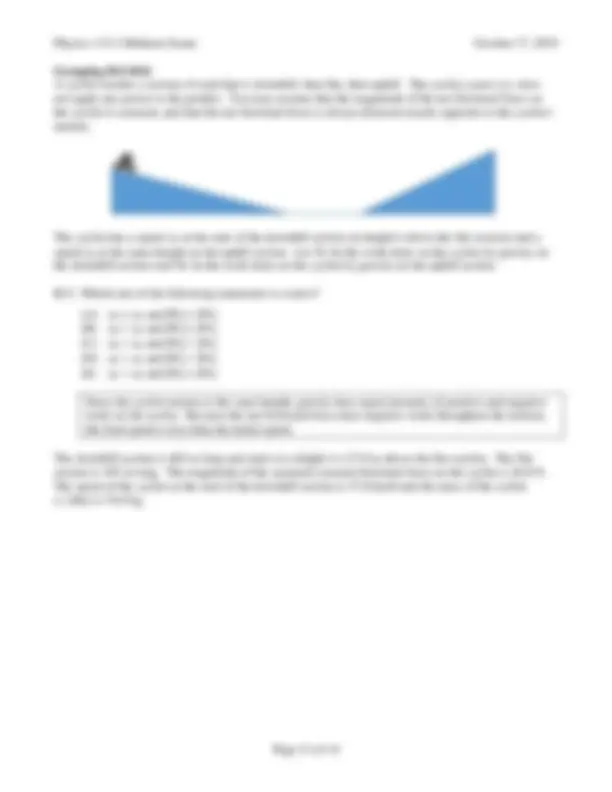
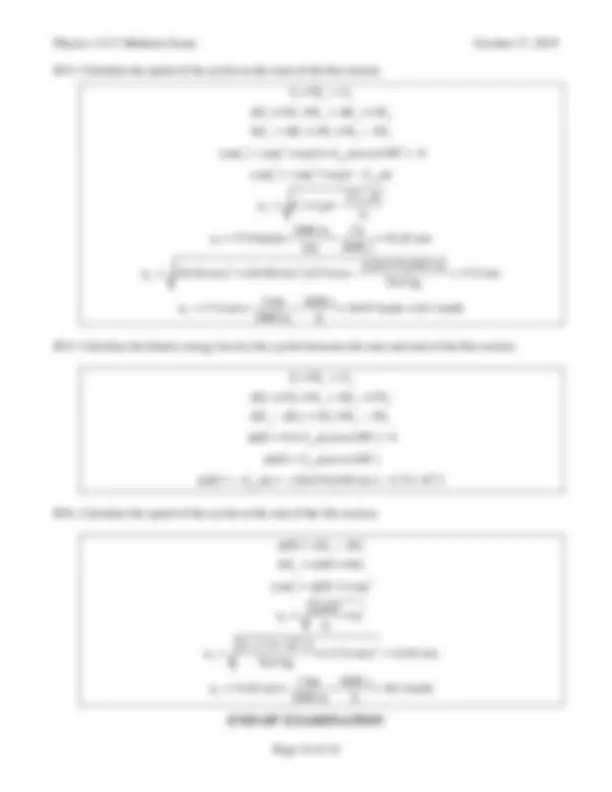


Study with the several resources on Docsity

Earn points by helping other students or get them with a premium plan


Prepare for your exams
Study with the several resources on Docsity

Earn points to download
Earn points by helping other students or get them with a premium plan
Community
Ask the community for help and clear up your study doubts
Discover the best universities in your country according to Docsity users
Free resources
Download our free guides on studying techniques, anxiety management strategies, and thesis advice from Docsity tutors
INSTRUCTIONS: 1. This is a closed book exam. 2. The test package includes a test paper (this document), an exam booklet ...
Typology: Exams
1 / 14

This page cannot be seen from the preview
Don't miss anything!









Department of Physics and Engineering Physics
October 2019 Time: 90 minutes
NAME: _______________ SOLUTIONS _____________________ STUDENT NO.: ____________ (Last) Please Print (Given)
LECTURE SECTION (please check):
01 Dr. M. Ratzlaff 02 A. Qamar 03 B. Zulkoskey 97 Dr. A. Farahani C15 Dr. A. Farahani
INSTRUCTIONS:
MARK out of 36:
A1. Forces F 1 and F 2 act on an object, with force F 2 acting in the positive x direction. From the free body diagram and coordinate system shown, which one of the following is the correct expression for the y component of 𝐹𝐹⃗ 1 + 𝐹𝐹⃗ 2?
(A) F 1 cos40° (B) – F 1 + F 2 cos40° (C) F 1 sin40° + F 2 cos40° (D) – F 1 sin 40° (E) F 1 sin40°
Since F 2
does not have a y -component, the y -component of F 1 (^) + F 2
is the y -component of F 1
Since the angle that is given is with respect to the y -axis, the y -component is + F 1 cos(40 )^ (A)
𝐹𝐹𝐹𝐹 4𝑚𝑚 , where F is force in Newtons, x is displacement in meters, and m is mass in kilograms (A) m/s 2 (B) m/s (C) m 2 /s (D) m 2 /s 2 (E) kg m/s
2 Nm ( kg m / s ) m (^) m (^2) (^) / s (^2) m / s kg kg
A3. Which one of the following values is a reasonable order-of-magnitude estimate of the volume of a medium-sized orange? (A) 1 cm 3 (B) 10 cm 3 (C) 100 cm 3 (D) 10 m 3 (E) 100 m 3
Approximate an orange as a sphere. The volume of a sphere is
3 4 3 3 4 3 1 3 3 4 4 2 8 2
d
where r is radius and d is diameter. A medium-sized orange will easily fit in the palm of your hand, so approximate its diameter as 7 to 8 cm. Therefore the volume is approximately 170 cm 3 to 250 cm 3. (C)
as it moves from one end to the other, while a man in a hurry to reach his flight walks on the
how much sooner does the man reach the end of the walkway?
υ
υ
υ
to the building. Therefore, the man will move the distance L in a time of 3
. The difference in
these times, which is how much sooner than the woman that the man reaches the end of the
walkway, is
A7. If an object is in equilibrium, which one of the following statements is FALSE?
(A) The object must be at rest. (B) The acceleration of the object is zero. (C) The net force acting on the object is zero. (D) The speed of the object is constant. (E) The velocity of the object is constant.
For an object in equilibrium, the net force acting on it, and therefore its acceleration, are zero. This means that the object is either at rest and remaining at rest, or is moving at constant velocity. The statement that the object must be at rest is false. (A)
A8. Three blocks are suspended from the ceiling by strings as shown. The top block has mass M, the middle block has mass 2M , and the bottom block has mass 3M. The tension in the string between the top block and the ceiling is T. What is the tension, T 1 , in the string connecting the bottom block and middle block?
(A) 3 T (B)
The external forces acting on the system of three blocks are T and the total weight of the three blocks. Since the three blocks are in equilibrium, the tension T must be equal in magnitude to M (^) tot g = (M + 2M + 3M) g = 6M g. Since the bottom block is in equilibrium, the net force on it
must be zero. Therefore, +T 1 – 3M g = 0, so T 1 = 3 M g =
A9. A painter holds a paint brush, of mass m , against the ceiling by applying a vertical force of magnitude F. The magnitude of the normal force of the ceiling on the brush is (A) F + m (B) F – m (C) F – mg (D) F + mg (E) 0
The net force on the paint brush in the vertical direction is zero. Choosing up to be the positive vertical direction, the forces on the paint brush are + F , − mg and − n. + F − mg − n = 0, so n = F − mg. (C)
A10. A person is holding a stone of mass m in her hand. The stone is initially at rest. She then throws
when she starts accelerating it to throw it upward until it reaches maximum height h?
The stone is initially at rest in the person`s hand, and is again at rest when it reaches maximum height. Therefore, there is no change in the kinetic energy of the stone, and therefore no net work is done on it. (B)
A11. A mass tied to the end of a string swings from its highest point down to its lowest point along a semi-circular trajectory. Let 𝑊𝑊𝑔𝑔, 𝑊𝑊𝑇𝑇 and 𝑊𝑊𝑎𝑎 represent work done by gravity, tension, and air resistance, respectively. Which one of the following statements is correct? (A) 𝑊𝑊𝑔𝑔 > 0, 𝑊𝑊𝑇𝑇 = 0, 𝑊𝑊𝑎𝑎 > 0 (B) 𝑊𝑊𝑔𝑔 > 0, 𝑊𝑊𝑇𝑇 > 0, 𝑊𝑊𝑎𝑎 < 0 (C) 𝑊𝑊𝑔𝑔 = 0, 𝑊𝑊𝑇𝑇 = 0, 𝑊𝑊𝑎𝑎 < 0 (D) 𝑊𝑊𝑔𝑔 < 0, 𝑊𝑊𝑇𝑇 = 0, 𝑊𝑊𝑎𝑎 < 0 (E) 𝑊𝑊𝑔𝑔 > 0, 𝑊𝑊𝑇𝑇 = 0, 𝑊𝑊𝑎𝑎 < 0
As the mass swings from high to low, its height above an arbitrary reference is decreasing, and therefore its gravitational potential energy is decreasing. Therefore, the gravitational force is doing positive work on the mass. Since the mass is moving along a semi-circular trajectory, the tension in the string is perpendicular to the motion, and therefore does no work. The air resistance force opposes the motion of the mass, so it does negative work. (E)
Grouping B1-B An athlete stands with his hand outstretched 7.00 m above the bottom of a cliff and throws a ball directly upward. After 3.40 s, the ball falls past its initial position. Eventually the ball lands at the bottom of the cliff. We ignore air resistance and choose the + y direction to be upward.
B1. Which one of the following graphs best represents the acceleration versus time graph for the motion of the ball from just after it is released until just before it hits the bottom of the cliff?
The acceleration is constant at −9.80 m/s 2
B2. Calculate the velocity of the ball at the instant it has left the athlete's hand.
Ignoring air resistance, when the ball returns to its initial position it will be moving with the same speed, but in the opposite direction
2
( 9.80 m/s )(3.40 s) 16.7 m/s 2
y y oy y oy oy y oy y oy
oy
a t
B3. Calculate the velocity of the ball just before it reaches the bottom of the cliff.
2 2 2
2 2
(16.7 m/s) 2( 9.80 m/s )( 7.00 m) 20.4 m/s
y oy y y oy y
y
B4. With respect to the bottom of the cliff, calculate the maximum height that the ball reaches.
At maximum height, the velocity is momentarily zero
Taking the initial position to be maximum height and the final position to be the bottom of the cliff:
(^2 2 ) 2 2 2
( 20.4 m/s) 0 2 21.2 m 2 2( 9.80 m/s )
y oy y oy y y
a y y a
B6. Calculate the time for the projectile to reach the target.
2 2 2
2
2
2 2( 9.80 m/s )( 4.40 m) 9.287 m/s
0 9.287 m/s 0.9476 s = 0.948 s 9.80 m/s
y oy y
oy y
oy y y oy y y oy y
a y
a y
a y a t
t a
B7. Calculate the speed with which the projectile was launched.
2 2
9.287 m/s 0.9476 s
16.0 m 16.88 m/s 0.9476 s 19.3 m/s
oy
ox
ox
o ox oy
t x t x t
B8. Calculate the angle above the horizontal at which the launcher was aimed.
arctan arctan 9.287 m/s 28.8^ o 16.88 m/s
oy o ox
υ θ υ
Grouping B9-B Two packing crates of masses m 1 = 5.00 kg and m 2 = 10.0 kg are connected by a light string that passes over a frictionless pulley as shown in the figure. The 5.00-kg crate lies on an incline of angle
crate and the inclined surface is 0.200.
B9. Which one of the following free-body diagrams best represents the forces acting on the 5.00-kg crate?
The forces acting on the 5.00-kg crate are the weight force vertically down, the normal force perpendicular to and away from the incline, the tension force up the incline and the frictional force down the incline.
B10. Let a represent the magnitude of the acceleration of the two crates. Which one of the following is the correct formula for the magnitude of the normal force of the incline on the 5.00-kg crate?
Since the net force perpendicular to the incline is zero, the magnitude of the normal force is equal
Grouping B13-B A cyclist reaches a section of road that is downhill, then flat, then uphill. The cyclist coasts (i.e. does not apply any power to the pedals). You may assume that the magnitude of the net frictional force on the cyclist is constant, and that the net frictional force is always directed exactly opposite to the cyclist's motion.
the downhill section and W 2 be the work done on the cyclist by gravity on the uphill section.
B13. Which one of the following statements is correct?
Since the cyclist returns to the same height, gravity does equal amounts of positive and negative work on the cyclist. Because the net frictional force does negative work throughout the motion, the final speed is less than the initial speed.
The downhill section is 465 m long and starts at a height h = 27.0 m above the flat section. The flat section is 105 m long. The magnitude of the assumed constant frictional force on the cyclist is 26.0 N. The speed of the cyclist at the start of the downhill section is 37.0 km/h and the mass of the cyclist (+ bike) is 76.0 kg.
B14. Calculate the speed of the cyclist at the start of the flat section.
1 2 1 2 o 2 2 1 2 1 2 2 2
2
2 2
(cos180 ) 0
1000 m 1 h 37.0 km/h 10.28 m/s km 3600 s
(10.28 m/s) 2(9.80 m/s )(
i nc f i i nc f f f i i nc f
f i fric f i fric
fric f i
i
f
m m mgh F x m m mgh F x
F x gh m
2(26.0 N)(465 m) .0 m) 17.8 m/s 76.0 kg 1 km 3600 s 17.8 m/s 64.07 km/h = 64.1 km/h f 1000 m h
B15. Calculate the kinetic energy lost by the cyclist between the start and end of the flat section.
o o 3
0 (cos180 ) 0
(cos180 ) (26.0 N)(105 m) 2.73 10 J
i nc f i i nc f f f i i nc f fric
fric fric
KE F x
KE F x KE F x
B16. Calculate the speed of the cyclist at the end of the flat section.
1 2 1 2 2 2 2
3 2
(17.8 m/s) 15.65 m/s 76.0 kg 1 km 3600 s 15.65 m/s 56.3 km/h 1000 m h
f i f i
f i
f i
f
f
m KE m
KE m